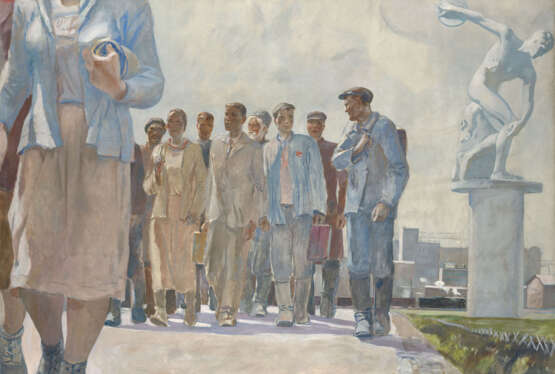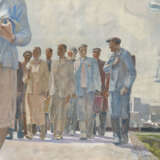ID 12362
Лот 10* | DEINEKA, ALEKSANDR (1899-1969) Heroes of the First Five-Year Plan.
Оценочная стоимость
£ 2 000 000
Executed c. 1936.
Provenance: Collection of the artist.
A gift from the above to the artist Nikolai Ponomarev.
Important private collection, USA.
Authenticity certificate from the expert T. Zeliukina.
Exhibited: Soviet Dis-Union. Socialist Realist and Nonconformist Art, The Museum of Russian Art, Minneapolis, 20 April–19 August 2006.
Literature: V. Swanson, Soviet Impressionism, Woodbridge, Antique Collectors’ Club, 2001, p. 69, pl. 41, illustrated as Construction (mural study).
Exhibition catalogue, Soviet Dis-Union. Socialist Realist and Nonconformist Art, Minneapolis, The Museum of Russian Art, 2006, p. 14, No. 5, illustrated; p. 45, pl. 7, illustrated; p. 44, listed as Study for a Mural.
V. Swanson, Soviet Impressionist Painting, Woodbridge, Antique Collectors’ Club, 2008, p. 65, pl. 45, illustrated as Construction (mural study).
Deineka. Zhivopis, Moscow, Interros, 2010, p. 115, No. 154, illustrated and listed as Eskiz monumentalnoi kompozitsii.
Related literature: For similar works, see A. Deineka, Zhizn, Iskusstvo, Vremia, Leningrad, Khudozhnik RSFSR, 1974, p. 153, illustrated; p. 87, mentioned in the text.
Exhibition catalogue, Aleksandr Aleksandrovich Deineka. 1899–1969. Vystavka proizvedenii k 80-letiiu so dnia rozhdeniia, Moscow, Izobrazitelnoe iskusstvo, 1980, p. 54, listed under years 1936 and 1937.
V. Sysoev (ed.), Aleksandr Deineka, Leningrad, Aurora Art Publishers, 1982, pl. 168, illustrated; p. 292, No. 208, listed; p. 280, mentioned under year 1936.
V. Sysoev, Aleksandr Deineka, Moscow, Izobrazitelnoe iskusstvo, 1989, p. 181, mentioned in the text.
Deineka. Zhivopis, Moscow, Interros, 2010, pp. 93, 96 and 113, Nos. 121, 134, 135 and 141, illustrated and listed; pp. 307–309, illustrated; pp. 406, 407, 470 and 471, details, illustrated.
Exhibition catalogue, Aleksandr Deineka. 1899–1969. An Avant-garde for the Proletariat, Madrid, Fundación Juan March, 2012, pp. 45 and 64, Nos. 29 and 7, illustrated.
Alexander Deineka’s two-metre canvas Heroes of the First Five-Year Plan is a unique example of the artist’s monumental work. It belongs to the most famous series of the very large representational compositions that develop the theme of the new Soviet “hero worker”, which Deineka created over the second half of the 1930s. All the paintings in this series, apart from the work offered for auction, are now in museum collections.
After returning in 1935 from an extensive foreign tour of the USA, France and Italy, where he held solo shows, Deineka was commissioned to design the Soviet pavilion for the 1937 International Exposition in Paris. It was the first exhibition of the achievements by the world powers in which the USSR was to take part, so the stakes for the Soviet government were as high as they could possibly be: the aim was to showcase all of the young socialist state’s varied triumphs and accomplishments. Deineka was entrusted with executing a 12-metre panel that was to hang on the walls of the Soviet exhibition’s main hall – the Hall of Glory – and to act as its keynote image.
Deineka decided that the theme of his future composition would be a festive march-past of “notable people in the Land of the Soviets” – miners, steelworkers, weavers, engineers, airmen and other heroes – who had delivered the first successes of the industrialisation policy proclaimed by the party. The actual idea was largely a continuation of the artist’s work with prints and posters, which in the 1930s were extensively developing a formula for marking a clear-cut contrast between “those who were celebrated and distinguished because of their work in the land of socialism” and those who were regarded as nobility in tsarist times – bureaucrats and officials, clergymen, landowners and police officers. In most of his monumental, multi-figure canvasses between 1936 and 1939, the artist applied himself to converting this ideological formula into artistic compositions.
The imposing canvas for the legendary Soviet pavilion, designed by the architect Boris Iofan and the sculptor Vera Mukhina, is known only from photographs, sketches and early versions. Deineka started work on the canvas in 1936. Two monumental paintings that the artist produced during those years while preparing for the International Exposition are still accessible to specialists. They are the Heroes of the First Five-Year Plan in the collection of the State Museum of Arts of the Republic of Kazakhstan (Almaty) and the eponymous picture that is now being auctioned, which was kept for many years in an American private collection.
The work displays features that are typical of the artist’s compositions at that time – flatness of space, concise colour scheme and minimalist treatment of the figures. As Tatiana Zeliukina, a specialist in the artist’s work, points out, these features are also combined with another, particular technique: “cropping so as to accommodate experimental searches” – this is how she defines the technique “of deliberately cutting off parts of the female figure in the foreground”.
Unlike his later works with a similar subject matter, in the early version of the Heroes of the First Five-Year Plan Deineka does not depict real historical persons – the miner Alexei Stakhanov, the pilot Valery Chkalov or the weavers Maria and Evdokia Vinogradovy – but rather the members of a single, cohesive team, who are walking towards the viewer. This constitutes a kind of generalised image of ordinary Stakhanovite workers and young Soviet “specialists”, the heroes of the first Five-year Plan; while their march is an allegory for the vast social transformations ushering in a socialist harmony.
A similar treatment in the depiction of Soviet people, moving in a single line at a rather heavy yet unstoppable pace, marked a new departure in the theme of the parade, which Deineka had pioneered in his Defence of Petrograd, painted in 1928. Inspired by Iofan’s design for the pavilion and by Mukhina’s Worker and Kolkhoz Woman sculpture that crowned it, Deineka turns the same images of Classical sculpture that can be perceived symbolically in the building’s architecture, into a leitmotiv of his monumental compositions. The obvious prototypes of the dynamic angle seen in the Worker and Kolkhoz Woman – the theme of the forward and upward movement of the Winged Victory of Samothrace and the design for joining the figures in the Tyrannicides statuary group by Kritios and Nesiotes – find a logical continuation in the Heroes of the First Five- Year Plan: the inclusion in the composition of the same Winged Victory of Samothrace or the Discobolus is meant to visually represent the Classical ideal as being the basis for the artistic doctrine of socialist realism.
At first glance, the depiction of the Classical statues (the Discobolus in the picture presented for auction, and the Winged Victory of Samothrace in the Almaty version) looks like nothing more than a romanticising device, with the whole scene being just the symbolic space of the new way of life. Yet surrounding the Stakhanovites with ancient Greek sculptures, Deineka was starting out from a concrete reality – the Gorky Central Park of Culture and Leisure (Moscow), where in the 1930s there used to be a Central Avenue, decorated with copies of Classical statues. Alongside it there was also a Shock Workers’ Avenue, in which the busts of the foremost workers were displayed. No less customary for people at the time were the mass parades of workers from the country’s factories, held regularly to mark all Soviet public holidays. Arguably, Deineka was not creating an imaginary picture of the new Soviet reality, but a generalised one.
Yet try as he might to conform to party and government guidelines, the great painter’s attitude to that reality can be unambiguously discerned in this work. People with heavy masklike faces, who virtually ignore the viewer (Oleg Tselkov was to pick up the baton of the masklike faces 30 years later), wearing crumpled overalls, dusty old shoes and tarpaulin boots, and all but walking in footcloths, wend their way after a long working day. Individualities are blurred, the crowd is monolithic, and there is even a figure with no visible head at all clomping along in the foreground. Indeed, what did a Soviet worker need a head for?! Nevertheless, the work does not produce a depressing impression. The canvas is grandiose: the semi-people marching straight towards the viewer, a powerful, colourless crowd. And at the same time an incredible contrast is conveyed by joyous lightness, floating in the air and practically perceptible by the viewer – the joy of the beginning of the New World, the starting point of existence. Communist nirvana...
More description at www.macdougallauction.com
| Адрес торгов |
MacDougall Arts Ltd. 33 St James’s Square SW1Y 4JS London Великобритания | ||||||||||||||
|---|---|---|---|---|---|---|---|---|---|---|---|---|---|---|---|
| Предосмотр |
| ||||||||||||||
| Телефон | +44 20 7389 8160 | ||||||||||||||
| Телефон | +7 495 799 4683 | ||||||||||||||
| Факс | +44 (0) 20 7389 8170 | ||||||||||||||
| Комиссия | 27 % | ||||||||||||||
| Условия использования | Условия использования | ||||||||||||||
| Часы работы | Часы работы
|




